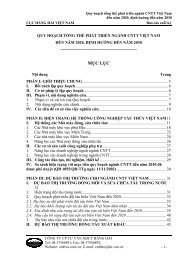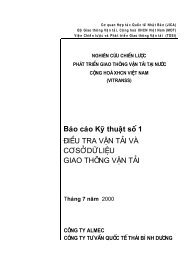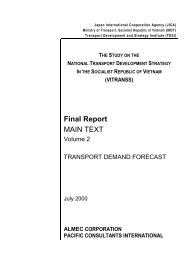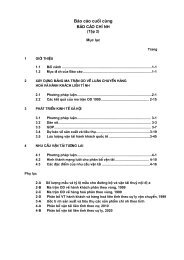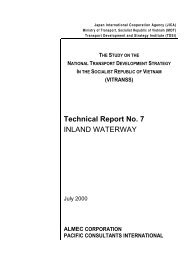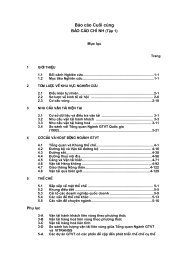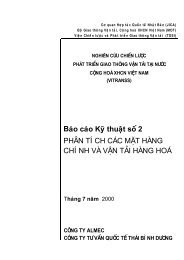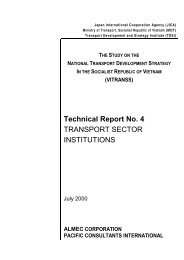Technical Report No. 8 PORT AND SHIPPING
Technical Report No. 8 PORT AND SHIPPING
Technical Report No. 8 PORT AND SHIPPING
Create successful ePaper yourself
Turn your PDF publications into a flip-book with our unique Google optimized e-Paper software.
5.3 Identified Projects for the Master Plan Period<br />
1) General<br />
II-5-9<br />
Vietnam National Transport Strategy Study (VITRANSS)<br />
<strong>Technical</strong> <strong>Report</strong> <strong>No</strong>. 8<br />
Shipping and Ports<br />
On the basis of the existing port master plan of MOT and estimated future<br />
traffic volume and characteristics, candidate projects for the VITRANSS<br />
master plan have been worked out.<br />
2) Port Development in <strong>No</strong>rthern Vietnam<br />
Port traffic in the Quang Ninh Port Group exceeds 18 million tons, which is<br />
around 19% of the total in Vietnam, while estimated container volume is<br />
585,000 TEUs, or around 17% of the total. However in the case of Hai Phong,<br />
port traffic has decreased, representing only 12% of the total and only 9% of<br />
the container traffic. It is necessary to construct a bulk terminal and a container<br />
terminal in the Quang Ninh Port Group to handle the projected 9.4 million tons<br />
of solid bulk and 585,000 TEUs of container. Container vessels prefer to call at<br />
Cai Lan Port instead of Hai Phong Port because the former has a 12 m-depth<br />
berth compared to the latter’s 9 m-berth. Therefore in 2010, mother vessels<br />
plying the Asian container route will call at Cai Lan and a large portion of feeder<br />
container from Hong Kong and domestic ports are expected to call at Hai<br />
Phong Port because it is easily accessible to cargo users.<br />
(1) Cai Lan Port Expansion Project<br />
The Hai Phong Port has been and will continue to play a key role for<br />
sustaining economic activities in northern Vietnam. However, since its<br />
physical nature as a river port does not allow large vessels, it is expected<br />
that such vessels (of 40,000 DWT) will call at Cai Lan Port which it can<br />
accommodate after capital dredging works are conducted. This port has<br />
big potential to be an international port (see Figure 5.3.1).<br />
Up to 2004 (Stage 1): Construction project is under bidding. The project is<br />
aiming at an expansion of Phase 1 of the Cai Lan Port to meet traffic<br />
demand in the immediate future up to the year 2004. Its capacity will be<br />
2.3 million tons and investment capital of US$ 108.4 million is required. It<br />
consists of the following conditions:<br />
• Construction of new berths: One berth for 40,000 DWT and two<br />
(container and general cargo) berths for 30,000 DWT. Length is 700 m<br />
and depth is –13 m.<br />
• Dredging works of inner channel<br />
• Construction will be completed within 28 months.<br />
Mid 2000s: A coastal space management study will be conducted<br />
between Mon Cai (Chinese border) and Thanh Hoa province to determine



